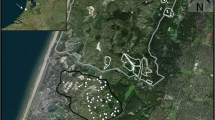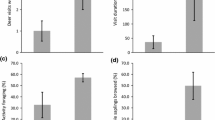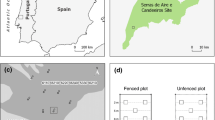Abstract
Large boulder grazing refugia permitted comparison of saxicolous bryophyte and lichen assemblages with those boulder tops accessible to red deer (Cervus elaphus) on a sporting estate in northwest Scotland. Plant succession was predicted to occur unchecked by grazing on the tops of these large boulders with cascading effects on bryophytes and lichens—assuming boulders had been in place over the same time period. Fifty pairs of boulders (one ≥2 m and the other accessible to red deer) were selected at random from various locations below north-facing crags. Percentage cover of each bryophyte and lichen species was estimated from three randomly placed quadrats on each boulder top. Due consideration was given to the influence of island biogeography theory in subsequent model simplification. Mean shrub cover and height, leaf-litter, bryophyte cover and bryophyte species richness were significantly higher within quadrats on large boulder tops that naturally excluded red deer. Lichen cover and lichen species richness were significantly higher on boulder tops accessible to red deer. Lichen cover was in a significant negative relationship with bryophyte cover, shrub cover and litter cover. Bryophyte cover showed a significant positive relationship with shrub height but there was an optimum shrub cover. Natural exclusion of red deer from the tops of large boulders has facilitated plant succession. The results suggest that grazing arrests the lithosere on boulder tops accessible to red deer at an early plagioclimax favouring saxicolous lichens. The results are relevant to situations where red deer might be excluded from boulder fields that hold lichen assemblages of conservation value.


Similar content being viewed by others
References
Air Pollution Information System (2013) Nitrogen deposition data. http://www.apis.ac.uk/. Accessed 7 Aug 2013
Arnesto JJ, Contreras LC (1981) Saxicolous lichen communities: nonequilibrium systems? Am Nat 118:597–604
Averis AM, Averis ABG, Birks HJB, Horsfield D, Thompson DBA, Yeo MJM (2004) An illustrated guide to British upland vegetation. Joint Nature Conservation Committee, Peterborough
Banta JA, Royo AA, Kirschbaum C, Carson WP (2005) Plant communities growing on boulders in the Allegheny National Forest: evidence for boulders as refugia from deer and as a bioassay of over-browsing. Nat Areas J 25:10–18
Bates JW (1992) Influence of chemical and physical factors on Quercus and Fraxinus epiphytes at Loch Sunart, western Scotland: a multivariate analysis. J Ecol 80:163–179
British Geological Survey (1962) Inverbroom: sheet 92. Ordnance Survey, Southampton
Church JM, Coppins BJ, Gilbert OL, James PW, Stewart NF (1996) British red data books: lichens, vol 1. Britain. Joint Nature Conservancy Council, Peterborough
Church JM, Hodgetts NG, Preston CD, Stewart NF (2001) British red data books: mosses and liverworts. Joint Nature Conservancy Council, Peterborough
Comisky L, Royo AA, Carson WP (2005) Deer browsing creates rock refugia Gardens on large boulders in the Allegheny National Forest, Pennsylvania. Am Midl Nat 154:201–206
Crawley MJ (2005) Statistics: an introduction using R. Wiley, Chichester
Crawley MJ (2013) The R book, 2nd edn. Wiley, Chichester
Crawley MJ, Albon SD, Bazely DR, Milner JM, Pilkington JG, Tuke AL (2004) Vegetation and sheep population dynamics. In: Clutton-Brock TH, Pemberton JM (eds) Soay sheep: dynamics and selection in an island population. Cambridge University Press, Cambridge, pp 89–112
Daniels MJ (2006) Estimating red deer Cervus elaphus populations: an analysis of variation and cost effectiveness of counting methods. Mamm Rev 36:235–247
Edwards T, Kenyon W (2013) Scottish Parliament Information Centre Briefing: Wild deer in Scotland. http://www.scottish.parliament.uk/ResearchBriefingsAndFactsheets/S4/SB_13-74. Accessed 8 Jan 2014
Elkington T, Dayton N, Jackson DL, Strachan IM (2001) National vegetation classification: field guide to mires and heaths. Joint Nature Conservancy Council, Peterborough
Fryday AM (2001) Effects of grazing animals on upland/montane lichen vegetation in Great Britain. Bot J Scot 53:1–19
Gilbert O (2000) Lichens. HarperCollinsPublishers, London
Hill MO, Blackstock TH, Long D, Rothero G (2008) A checklist and census catalogue of British and Irish bryophytes. British Bryological Society, Cheshire
Hodgetts NG (1997) Atlantic bryophytes in Scotland. Bot J Scot 49:375–385
James PW, Hawksworth DL, Rose F (1977) Lichen communities in the British Isles: a preliminary conspectus. In: Seaward MRD (ed) Lichen ecology. Academic Press, London, pp 31–68
Kimmerer RW, Driscoll MJL (2000) Bryophyte species richness on insular boulder habitats: the effect of area, isolation and microsite diversity. Bryologist 103:748–756
Long ZT, Carson WP, Peterson CJ (1998) Can disturbance create refugia from herbivores: an example with hemlock regeneration on tree-fall mounds. J Torrey Bot Soc 125:165–168
MacArthur RH, Wilson EO (1967) The theory of island biogeography. Princeton University Press, Princeton
Macdonald D, Barrett P (1993) Mammals of Britain and Europe. HarperCollinsPublishers, London
Meteorological Office (2013) UK mapped climate averages. http://www.metoffice.gov.uk/climate/uk/averages/ukmapavge.html. Accessed 7 Aug 2013
Milchunas DG, Noy-Meir I (2002) Grazing refuges, external avoidance of herbivory and plant diversity. Oikos 99:113–130
Milner R, Alexander J, Griffin C (2002) A highland deer herd and its habitat. Red Lion House, London
Mitchell B, Truscot AM, Leith ID, Cape JN, Van Duk N, Tang YS, Fowler D, Sutton MA (2005) A study of the epiphytic communities of Atlantic oak woods along an atmospheric nitrogen deposition gradient. J Ecol 93:482–492
Moore O, Crawley M (2014) Red deer exclusion and saxicolous cryptogam community structure. Lichenol 46:229–244
Orange A (2009) Saxicolous lichen and bryophyte communities in upland Britain. Joint Nature Conservation Committee Report No. 404
Porley R, Hodgetts N (2005) Mosses and liverworts. HarperCollins Publishers, London
R Development Core Team (2010) R: a language and environment for statistical computing. R Foundation for Statistical Computing, Vienna
Rodwell JS (1991) British plant communities, vol 2., Mires and heathsCambridge University Press, Cambridge
Rodwell JS (1992) British plant communities, vol 3., Grasslands and montane communitiesCambridge University Press, Cambridge
Rooney TP (1997) Escaping herbivory: refuge effects on the morphology and shoot demography of the clonal forest herb Maianthemum canadense. J Torrey Bot Soc 124:280–285
Smith CW, Aptroot A, Coppins BJ, Fletcher A, Gilbert OL, James PW, Wolseley PA (2009) The lichens of Britain and Ireland. British Lichen Society, London
Stace CA (2010) New Flora of the British Isles, 3rd edn. Cambridge University Press, Cambridge
Thomson J, Bryce J, Scott R, Horsfield D (2006) Deer management. In: Shaw P, Thompson DBA (eds) The nature of the Cairngorms: diversity in a changing environment. The Stationery Office, Edinburgh, pp 367–379
Virtanen R, Crawley M (2010) Contrasting patterns in bryophyhte and vascular plant species richness in relation to elevation, biomass and Soay sheep on St. Kilda, Scotland. Plant Ecol Div 3:77–85
Virtanen R, Oksanen J (2007) The effects of habitat connectivity on cryptogam richness in a boulder meta-community. Biol Conserv 135:415–422
Weibull H, Rydin H (2005) Bryophyte species richness on boulders: relationship to area, habitat diversity and canopy tree species. Biol Conserv 122:71–79
Acknowledgments
We thank the owners of Letterewe Estate for funding this research and for the provision of accommodation. We are also grateful to Brian Coppins for his assistance with identifying some of the more difficult lichen specimens. The comments and suggestions made by the anonymous reviewers on an earlier draft of this manuscript were very much appreciated.
Author information
Authors and Affiliations
Corresponding author
Additional information
Communicated by T. G. Allan Green.
Electronic supplementary material
Below is the link to the electronic supplementary material.
Rights and permissions
About this article
Cite this article
Moore, O., Crawley, M.J. The natural exclusion of red deer from large boulder grazing refugia and the consequences for saxicolous bryophyte and lichen ecology. Biodivers Conserv 23, 2305–2319 (2014). https://doi.org/10.1007/s10531-014-0725-3
Received:
Revised:
Accepted:
Published:
Issue Date:
DOI: https://doi.org/10.1007/s10531-014-0725-3




